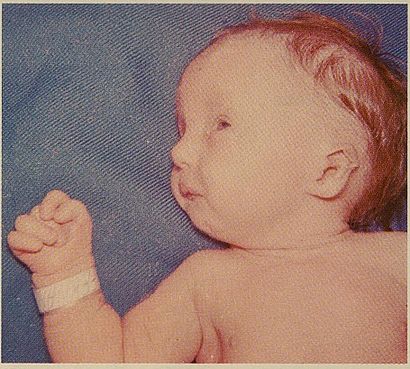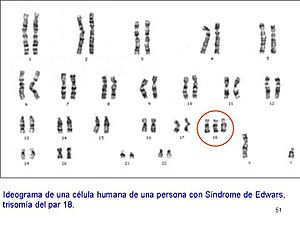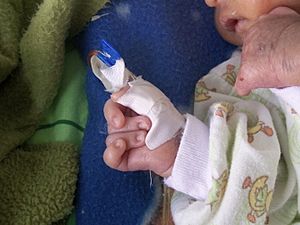Trisomy 18 facts for kids
Quick facts for kids Trisomy 18 |
|
|---|---|
| Synonyms | Trisomy 18 (T18), chromosome 18 duplication, trisomy E syndrome |
 |
|
| Infant with trisomy 18 | |
| Symptoms | Small head, small jaw, clenched fists with overlapping fingers, profound intellectual disability |
| Complications | Heart defects |
| Usual onset | Present at birth |
| Causes | Third copy of chromosome 18 (usually new mutation) |
| Risk factors | Older mother |
| Diagnostic method | Ultrasound, amniocentesis |
| Treatment | Supportive care |
| Prognosis | 5–10% survive past a year old |
| Frequency | 1 per 5,000 births |
Trisomy 18, also known as Edwards syndrome, is a genetic disorder. It happens when a baby has an extra copy of chromosome 18. This extra chromosome affects many parts of the body.
Babies with Trisomy 18 are often born smaller than average. They can also have heart problems. Other common features include a small head, a small jaw, and hands with fingers that are often clenched and overlapping. They may also have significant intellectual disability.
Most of the time, Trisomy 18 happens by chance. It's usually due to a problem when reproductive cells (sperm or egg) are forming. The chance of having a baby with this condition goes up as the mother gets older. Very rarely, it can be passed down in families.
Sometimes, only some of the body's cells have the extra chromosome. This is called mosaic trisomy. In these cases, the symptoms might be less severe. Doctors can suspect Trisomy 18 during pregnancy using an ultrasound. A test like amniocentesis can then confirm it.
Treatment for Trisomy 18 focuses on supportive care. This means helping with the symptoms and making the child as comfortable as possible. Trisomy 18 is the second most common condition caused by an extra chromosome at birth, after Down syndrome. It affects about 1 in 5,000 live births. Many babies affected by it do not survive before birth. About 5–10% of babies born with Trisomy 18 live past their first year. The syndrome is named after John Hilton Edwards. He was an English geneticist who first described it in 1960.
Contents
Understanding the Signs and Symptoms
Children born with Edwards syndrome can have many different features. They might have problems with their kidneys. Many also have heart problems from birth. These can include holes in the heart walls.
Other signs can be:
- Intestines sticking out of the body (omphalocele).
- Problems with the esophagus, making feeding hard.
- Intellectual disability and delays in development.
- Difficulty growing and feeding.
- Trouble breathing.
- Arthrogryposis, which causes joints to be stiff and bent.
Physical Features of Edwards Syndrome
Babies with Edwards syndrome often have specific physical traits. These include a small head (microcephaly) with a noticeable back part (occiput). Their ears might be low-set and not fully formed. They can also have a very small jaw (micrognathia).
Other physical signs can be:
- Cleft lip or cleft palate.
- An upturned nose.
- Narrow eyelid openings (blepharophimosis).
- Eyes that are far apart (ocular hypertelorism).
- Drooping of the upper eyelids (ptosis).
- A short breast bone.
- Hands that are clenched, often with fingers overlapping.
- Underdeveloped thumbs or nails.
- Missing bones in the forearm (absent radius).
- Webbed toes (especially the second and third toes).
- Clubfoot or rocker bottom feet.
What Doctors See Before Birth
When a baby with Trisomy 18 is still inside the mother, doctors often see certain things on an ultrasound. The most common findings are heart problems. They might also see unusual head shapes.
A common finding in the brain is choroid plexus cysts. These are small fluid-filled sacs. They are usually not harmful by themselves. However, they can sometimes be a sign of Trisomy 18. Sometimes, there might be too much amniotic fluid around the baby. This is called polyhydramnios. Trisomy 18 can also cause a brain condition called Dandy–Walker malformation, though this is less common.
Understanding the Genetics

Trisomy 18 is a chromosomal abnormality. This means there is an extra copy of genetic material on chromosome 18. This extra copy can be a whole extra chromosome 18. Or it can be just a part of it, due to something called a translocation.
The extra chromosome usually happens before a baby is conceived. The effects of this extra copy can vary a lot. It depends on how much extra material there is. It also depends on the child's genetic background and other random factors. Trisomy 18 can happen in all people. It is seen more often in female babies.
How the Extra Chromosome Happens
Normally, an egg or sperm cell has 23 individual chromosomes. When an egg and sperm combine, they form a cell with 23 pairs, making 46 chromosomes in total. This is a normal human karyotype.
Sometimes, errors happen when egg or sperm cells are forming. A chromosome might not separate correctly into the new cells. This is called nondisjunction. It results in an egg or sperm cell having an extra chromosome. So, it has 24 chromosomes instead of 23. When this cell combines with a normal cell from the other parent, the embryo ends up with 47 chromosomes. This means it has three copies of chromosome 18 instead of two.
A small number of cases are different. In these cases, only some of the body's cells have the extra chromosome 18. This is called mosaic Trisomy 18. The body has a mix of cells, some with the extra chromosome and some without.
Very rarely, a piece of chromosome 18 breaks off. It then attaches to another chromosome. This can happen before or after conception. People with this type have a partial Trisomy 18. Their symptoms are often less severe than those with a full extra chromosome 18.
How Doctors Diagnose Trisomy 18
Doctors can first suspect Trisomy 18 during a pregnancy ultrasound. This imaging test can show signs that suggest the condition. To confirm the diagnosis, doctors can perform other tests. These include CVS or amniocentesis. These tests check the baby's chromosomes directly.
During pregnancy, doctors can also check levels of certain substances in the mother's blood. These include PAPP-A, AFP, uE3, and free β-hCG. In pregnancies affected by Trisomy 18, these levels are usually lower than normal.
What to Expect: Prognosis
About 95% of pregnancies affected by Trisomy 18 do not result in a live birth. For babies born with the condition, major causes of death include problems with breathing (apnea) and heart issues. It is very hard to know exactly what will happen during pregnancy or right after birth.
About half of the babies born with Trisomy 18 do not survive past their first week of life. The average lifespan is usually between 5 and 15 days. However, about 8–12% of infants live longer than 1 year. Some studies have shown that about 1% of children with Trisomy 18 live to age 10. Recent studies suggest that with medical and surgical help, more children are surviving longer.
How Common is Trisomy 18?
Trisomy 18 happens in about 1 out of every 5,000 live births. However, more pregnancies are affected by the syndrome. This is because most babies diagnosed with the condition before birth do not survive to be born.
Women in their 20s and early 30s can have babies with Trisomy 18. But the risk of having a baby with this condition increases as the mother gets older. The average age for a mother to have a child with Trisomy 18 is around 32.5 years old.
History of Discovery
Trisomy 18 was first identified in 1960 by a scientist named John Hilton Edwards. At first, he thought it was caused by an extra chromosome 17. Soon after, two other scientists, Klaus Patau and Eeva Therman, reported more cases. They figured out that the extra chromosome was part of a group they called "group E," which included chromosomes 16, 17, and 18. After studying more cases, they confirmed that the extra chromosome was indeed chromosome 18.
See also
- 18q deletion syndrome
 In Spanish: Síndrome de Edwards para niños
In Spanish: Síndrome de Edwards para niños


